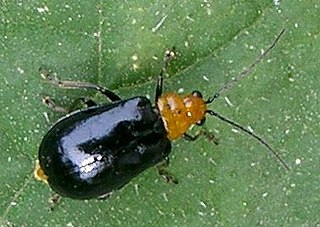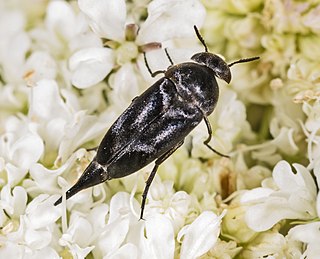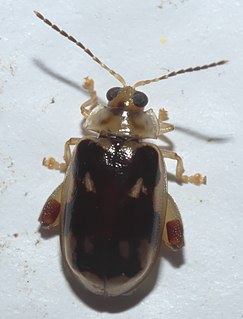
Johan Christian Fabricius was a Danish zoologist, specialising in "Insecta", which at that time included all arthropods: insects, arachnids, crustaceans and others. He was a student of Carl Linnaeus, and is considered one of the most important entomologists of the 18th century, having named nearly 10,000 species of animals, and established the basis for the modern insect classification.
Christian Rudolph Wilhelm Wiedemann was a German physician, historian, naturalist and entomologist. He is best known for his studies of world Diptera, but he also studied Hymenoptera and Coleoptera, although far less expertly.

Buprestis is a genus of beetles in the tribe Buprestini, the jewel beetles. As of 2011 there were 78 described species distributed across most of the world's biogeographic realms except parts of Africa and Antarctica.

Friedrich Weber was a German physician, botanist and entomologist. He was a pupil of Johan Christian Fabricius (1745–1808), and wrote Nomenclator entomologicus in 1795 at the age of 14 and Observationes entomologicae in 1801. These two works contained the first descriptions of many new insect species and also first descriptions of other invertebrates like the lobster genus Homarus.

Calosoma is a genus of large ground beetles that occur primarily throughout the Northern Hemisphere, and are referred to as caterpillar hunters or caterpillar searchers. Many of the 167 species are largely or entirely black, but some have bright metallic coloration. They produce a foul-smelling spray from glands near the tip of the abdomen. They are recognizable due to their large thorax, which is almost the size of their abdomen and much wider than their head.

Aulacophora is a genus of beetles in the family Chrysomelidae, commonly known as pumpkin beetles; some species are pests of agricultural crops. The genus was named in 1836 by the French entomologist Louis Alexandre Auguste Chevrolat, in Dejean's Catalogue des Coléoptères. The name, from Ancient Greek, signifies "furrow-bearer"' from aulax, "furrow".

Melandryidae is a family of false darkling beetles in the order Coleoptera. There are at least 40 genera and 100 described species in Melandryidae.

Mordella is the type genus of the tumbling flower beetle family (Mordellidae), its subfamily Mordellinae and the tribe Mordellini. It is widely distributed in the Holarctic and adjacent regions. The larvae are primarily dead wood borers.
Events from the year 1744 in Denmark.

Carabinae is a subfamily of beetles in the family Carabidae, containing the following genera:
Copelatus posticatus is a species of diving beetle. It is part of the subfamily Copelatinae in the family Dytiscidae. It was described by Fabricius in 1801.
Chelonariidae or turtle beetles is a family of beetles in the superfamily Byrrhoidea. It was described by Blanchard in 1845.

Astathes is a genus of longhorn beetles of the subfamily Lamiinae.

Sthenias is a genus of longhorn beetles of the subfamily Lamiinae, containing the following species:

Ophraella is a genus of beetles belonging to the family Chrysomelidae.

Sthenias grisator is a species of beetle in the family Cerambycidae. It was described by Johan Christian Fabricius in 1787, originally under the genus Lamia. It is known from India. It feeds on Erythrina variegata, Manihot utilissima, Morus alba, Tabernaemontana alba and Vitis vinifera.
Disonycha is a genus of flea beetles in the family Chrysomelidae, containing some 170 species in the Nearctic and Neotropics.

Kuschelina is a genus of flea beetles in the family Chrysomelidae. There are some 30 described species, from the Nearctic and Neotropics.

Capraita is a genus of flea beetles in the family Chrysomelidae. There are some 60 described species in the Nearctic and Neotropics.














